Same Old Script
On screen, TV is more diverse than ever. Why aren’t writing staffs catching up?

Photo illustration by Lisa Larson-Walker. Photos by PhotoAlto/Sigrid Olsson/Getty Images, shironosov/Thinkstock.
In 2013, within two weeks of beginning the highly competitive Disney-ABC Writing Program, Natasha “Tash” Gray landed a position as a staff writer on the Disney Channel show Dog With a Blog. The long-running program, which each year accepts around eight individuals out of about 2,000 applicants, was one of several network-run fellowships Gray participated in, but the first one that resulted in a staff position. As anyone who’s been a staff writer for a TV show will tell you, being the new face is all about learning and adjusting to the writers’ room; it’s like being a rookie on a pro sports team. “You’re not expected to talk as much, you’re not expected to weigh in as much because you’re at the bottom,” said Gray. “You don’t have that much weight.” Still, Gray was able to get some of her ideas on the story board while working at Dog With a Blog, and received a paid assignment to write a script—a coup that not all of her program cohorts staffed on other shows pulled off.
Gray was the only person of color in the writers’ room; the rest of the staff, seven men and one woman, were white. One day, around the time of George Zimmerman’s trial for killing Trayvon Martin, the writers were batting around ideas when a male colleague made a racially motivated joke. (Gray asked me not to retell the joke in question.) Her colleagues laughed. Gray’s vocal reaction was swift, instinctual: “Oh, hell no!”
On screen, things are looking up for people of color in the television industry. Thank the “Shonda Effect,” a term inspired by Grey’s Anatomy creator Shonda Rhimes’ commitment to casting people of color in lead roles in all of her hit shows. Hollywood has taken note of Rhimes’ ascendance, as well as her outspoken insistence on diversity in her work. The success of Scandal in particular—when it premiered in 2012, it was the first network drama with a black woman as its lead in nearly four decades—seems to have prompted a call for more stories centered around people of color. It’s safe to say that if it weren’t for Rhimes and her eclectic casts (and writers’ rooms), we would never have gotten so many shows rich with people of color on screen and off. The 2014–15 season, which saw the premieres of Jane the Virgin, Fresh Off the Boat, Black-ish, and the juggernaut that is Empire—featuring primarily Latino, Asian, and black casts, respectively—has been championed as the ultimate manifestation of that influence (it’s also been deemed, ludicrously, an ominous sign that white actors are no longer in demand in Hollywood). The new fall season has brought with it Rosewood (starring Morris Chestnut), Quantico (Bollywood star Priyanka Chopra), and Dr. Ken (Ken Jeong), all hoping to find an audience and survive the chopping block.
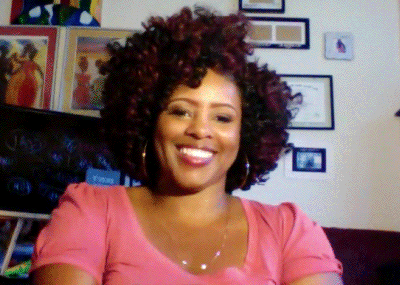
Animation by Tash Gray and Lisa Larson-Walker
But the view behind the scenes is less encouraging. Setting aside the impressively diverse staffs of those few Rhimes and Rhimes-adjacent series, writers’ rooms, like the one Gray was in on Dog With a Blog, are still overwhelmingly white and male, as are the high-powered positions of showrunner and executive producer. A Writers’ Guild of America report released earlier this year noted that staff employment for people of color actually decreased between the 2011–12 season and 2013–14 season, from a peak of 15.6 percent to 13.7 percent. The number of executive producers of color also decreased in those seasons, from 7.8 percent to 5.5 percent. While the 2014–15 season may have seen those numbers increase thanks to the addition of a few shows with diverse casts, such sharp declines demonstrate how tenuous progress in Hollywood can be.
The Rhimes effect onscreen is real. But can the remarkable diversity in those few writers’ rooms spread to shows across the television landscape? Can the writers of color staffing those writers’ rooms on hit series get their chance to become showrunners and executive producers two, three, five years down the road? Will the 2015 television season be a tipping point, or just a blip, akin to the brief heyday of black sitcoms in the 1990s?
In more than 20 interviews conducted over the past few months with writers (nonwhite and white, young and seasoned), executive producers, and directors of diversity programs and committees, a picture emerged of an industry that’s not even close to “normalizing”—to borrow a term from Rhimes—so that it more accurately represents what America looks like today. Instead, the television industry, like most creative industries (including journalism), pays lip service to “diversity” while very little actually changes. Even as the hottest show on TV boasts a majority-nonwhite writing staff, the work of vigorously recruiting non-white writing talent is still confined to a narrow pipeline: Diversity departments and fellowships help to fill one or two designated diversity slots on each staff. And that’s just the start of the problem: As writer after writer revealed, even when writers of color make it into that pipeline, the industry hasn’t gotten much better at making them feel as though their voices matter.
Tash Gray’s “Oh, hell no!” came as a surprise to her. The colleague who made the joke apologized—and then everyone quickly moved on. (“Or they moved on,” Gray said, chuckling. “I was still sitting there mad as hell!”) The offending writer was not seriously suggesting that such a joke would ever work in the script of an innocuous Disney Channel show. “He was just being funny in an insensitive way,” she said. “I don’t think he realized when he said it how offensive it would be. He didn’t think from my perspective, you know what I mean? He didn’t have to.”
* * *
The ladder to becoming the boss on a TV show is a towering one. The WGA designates the ascending rungs as follows: staff writer; story editor; executive story editor; writer-producer (a broad category that includes co-producer, producer, and supervising producer); and, finally, executive producer/showrunner. (Most staffers in those producer roles are also writers, with considerably more responsibility than a staff writer or story editor.) Those top rungs are mostly white: People of color occupied just 5.5 percent of the executive producer roles in the 2013–14 season. What may be more surprising is how white the bottom rungs are too. “I once had two Korean-Americans on staff, and I was actually asked by a network executive if I had an Asian fetish,” said Glen Mazzara, co-chair, along with Shonda Rhimes, of the Diversity Advisory Group for WGA West and a former showrunner for The Walking Dead. “These things sound ridiculous when you hear them, but this is not 15 [years ago]—that’s a couple years ago.”
Diversity is still ostensibly a priority, and that’s where diversity programs like the WGA’s, as well as those established under the auspices of the major networks, come in. Mostly founded in the past 20 years, the fellowships employ mentoring and networking assistance to bring people of color (as well as other underrepresented groups like women, LGBTQ people, and those with disabilities) into the fold. Access to these programs is highly competitive: Generally, fewer than 10 writers are selected each year from hundreds, sometimes thousands, of submissions. It’s common for writers to apply to programs multiple times over several years. And once you get in, it doesn’t mean you’re automatically on the path toward becoming a showrunner.
Often, in fact, a diversity program leads not to a job but to … another diversity program or fellowship. Tash Gray applied to the ABC-Disney fellowship only after her time in NBC’s Writers on the Verge—both of which are actually open to anyone, regardless of ethnicity and gender, though preference may be given to diverse candidates—failed to land her a spot in a writers’ room. She playfully refers to herself and others who have hopped from one program to another as “program pimps.”
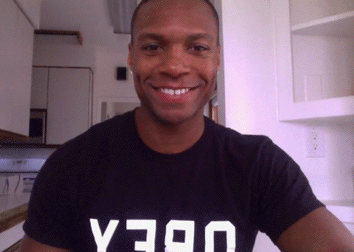
Animation by Ben Cory Jones and Lisa Larson-Walker
No writer I spoke to who’d been through a diversity program sounded ungrateful for the opportunity it afforded. The programs do help writers make connections and get jobs—some, in fact, like NBC’s Diverse Staff Writing Initiative, directly pay series to employ a “diverse” staff writer every season. But that well-intentioned initiative, in practice, turns into an act of tokenism, as typically a show finds that one “diversity” hire is all it needs. This is also true of series that don’t benefit from such initiatives. “We’ll hear that XYZ show needs a black writer, because Taye Diggs is in the show,” said Ben Cory Jones, who is developing a half-hour comedy for HBO. “And we all know that they have one slot, and one of us is gonna get it.” Recalled executive producer Danielle Sanchez-Witzel (The Carmichael Show, New Girl), who was part of NBC’s diversity initiatives in the early ’00s: “I was fighting every diversity person, of any ethnic diversity, for one spot. ... The other 10 spots on the staffs I’ve been on, for the most part, have been for white male writers.”
Mazzara noted that while producers seem more receptive to hiring nonwhite writers in recent years, the employment numbers are still “stagnant or slipping.” Where there has been improvement in diversifying TV, it’s often been because the executive producer makes it a priority. Take black stand-up comedian Jerrod Carmichael, whose The Carmichael Show is based in large part on his family and personal life, and, in its six-episode first season, tackled Black Lives Matter, gun control, and religion. Carmichael’s writers’ room is split evenly between white and nonwhite staffers. Before she became the showrunner for The Carmichael Show, Sanchez-Witzel told me that in more than 10 years in writers’ rooms, she’d “never been on a staff that had big numbers of ethnically diverse people.”
Why is that? Why doesn’t a constant pipeline—even if it’s a narrow one—of writers of color getting entry-level jobs translate into more diverse writers’ rooms? Why don’t many of those writers get a second job, a third, fifth, or ninth job? Being a television writer is a tough job, and it isn’t made any easier when your co-workers view you as a token. Sanchez-Witzel recalled being caught off guard when, early in her career, a higher-level writer asked her, “What does it feel like to be here because of your last name?" Amy Aniobi, currently working on a new HBO comedy called Brothers in Atlanta, told me that she’s seen staff lists circulated in which the diversity writer is labeled as “diversity writer so-and-so”: “Everyone knows who the diversity writer is. You’re the one who’s the only one.”
Nonwhite writers don’t want to be “the only one”; like all writers, they want to craft great stories and characters. And they definitely don’t want their colleagues to think they only got the job because the network reserved a chair for a “diversity hire.”
Of course, not all writers of color who secure a staff job on a TV show have done so through a diversity program or fellowship. The common theme among writers I spoke with who bypassed that process was that they all had powerful mentors who saw their talent and potential and who went to bat for them. Aniobi saw her career gain steam when she landed assistant jobs with executive producer Hilary Winston, and then, upon Winston’s recommendation, Happy Endings showrunner Jonathan Groff. Jamie Turner’s (Rosewood) boss on the early ’00s comedy One on One was aware that he wanted to work in drama, and reached out on his behalf to his friend, Shawn Ryan, creator of The Shield, setting off a fortuitous chain of events. And long before landing in the room for Season 2 of Empire, Carlito Rodriguez’s mentor, Hollywood vet Jeff Wald, got him meetings with producers all over town.
But whether you’re on staff with the help of a diversity program or after rising through the ranks in a more traditional way, you still face the challenge of being the only writer of color in the room. Most of the writers I spoke with underlined a very distinct feeling, a mix of relish and annoyance, about this role. Jones, who in the past has written for ABC Family’s Chasing Life and more recently the Amazon series Hand of God, said he’s appreciated being considered an “expert” on black or gay issues in the writers’ room. Still, it can be taxing. “It’s like, now that you have a black friend you can ask them all your black friend questions,” he said.
In one writers’ room, Aniobi recalled, her fellow writers had a black character greeting other characters, “What up, D? What up, B?” “I spoke up, and I was like, ‘Uh, I don’t think this character would say that.’ And everyone turned and looked at me, and I was like, ‘Black people don’t talk like that.’ ” She recalled everyone in the room laughed, and asked, “Well, how do they talk?” “And I was like, ‘Oddly enough, just like me or you.’ ”
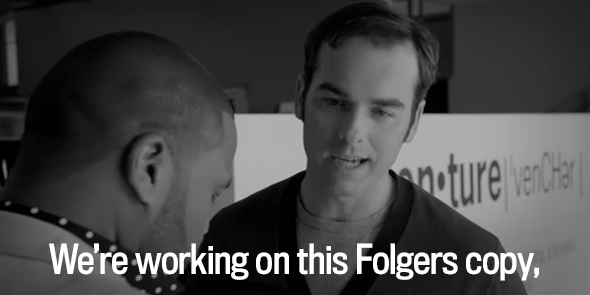
Stills via ABC, animation by Lisa Larson-Walker
After Gray’s startling incident with her Dog With a Blog co-worker’s racially insensitive joke, she was more cautious about how she reacted to the little things her co-writers would say and began to keep a tally of all of the moments that she “let go” without saying anything. Nonetheless, her co-workers began to think of her as a dampening influence in the writers’ room, the person who would say, “We can’t say that!”—even referring to her, in a running joke, as “Standards and Practices.” “Someone made me a little flag,” she remembered, “ ’cause they would say ‘Standards and Practices may flag something.’ ” Eventually, Gray embraced the role. “I was like, gimme that flag. And I would just hold the flag up. Sometimes I wouldn’t even say nothing, I would just be like, Mm-mm!”
But not all co-workers respond to being “flagged” with equanimity. Consider the incident between Wyatt Cenac and Jon Stewart on The Daily Show, as recalled by Cenac on Marc Maron’s WTF podcast. The confrontation came about because Cenac objected to Stewart’s impression of Herman Cain, comparing it to Amos ’n’ Andy. According to Cenac, Stewart exploded and told him to “fuck off.” “When you’re the one—whether you want to or not—you wind up speaking for everybody,” Cenac said.
Writers who speak up in the room aren’t just doing it out of a sense of political correctness. They’re doing it because they know that three-dimensional characters of color make their shows better—and because they know that white writers don’t always get it right. As pretty much any person of color can tell you, it’s easy to tell from watching a series whether there weren’t enough people of color in the writing room. Sex and the City was notoriously terrible at presenting its non-white characters (sample quote: “Yes, he does have a big black cock”). But there are other, more recent examples as well, such as Unbreakable Kimmy Schmidt with its poorly executed Native American backstory, and the mystifyingly long-running comedy Two Broke Girls, which traffics in troublesome racial stereotypes, particularly with regard to its Asian character, Han Lee.
In a recent showrunners’ roundtable convened by the Hollywood Reporter, Empire’s Lee Daniels was typically blunt: “I hate white people writing for black people; it’s so offensive. So we go out and look specifically for African-American voices.” When writers of color are in a room, and writing for a character who looks like them, it’s an opportunity to make sure that character is a full-fledged personality and not a one-dimensional stereotype. It’s important to diversify writing staffs for shows with white-led casts, so as to counter and minimize lame one-dimensional characterizations. But equally important is populating the television landscape with shows centered around nonwhite characters and giving them diverse writers to match.
For Rosewood, Fox’s drama starring Morris Chestnut as a Miami pathologist, the writers’ room is mixed, with several black writers and a Latina, according to Jamie Turner. At one point, a line was pitched that described Chestnut’s character as the absolute best in his field—“the LeBron James of pathology.” “That right there feeds into any and every stereotype,” Turner said. Chestnut objected, telling the writers, “You don’t necessarily got to compare me to a black dude who’s the best at what he does, especially when it’s sports,” according to Turner. In an all-white writers’ room, would Chestnut have been able to make that request? In a writers’ room with just one person of color, would the other writers feel obliged to accommodate him? It’s hard to tell. But in this diverse room, the writer changed the line, comparing Chestnut’s character to Beethoven instead.
* * *
“I am making TV look like the world looks,” Shonda Rhimes said last spring. Her writers’ rooms look like the world looks too, as do those of several other recent shows, including Empire, that have struck a chord with audiences of all colors. That’s a testament to those writers and their dedication to presenting their worlds as truly as they can. Take Empire’s off the cuff (but significant) references to blackness: When a character employs the slang term thot, for example, or calls mainstream media “white TV.” Or take Jane the Virgin’s liberal use of Spanish when Jane’s grandmother is speaking, forcing us non-Spanish-speaking viewers a bit out of our comfort zones with subtitles. The accumulation of these moments make the shows’ worlds feel real and familiar to audiences not used to being served by, well, white TV.
These opportunities are encouraging to writers of color, and validating, too. When I spoke with Rodriguez, he was only a few weeks into his first season on Empire, and his giddiness about working in an “overwhelmingly” black environment was palpable. “It feels very dope to me to be able to put things on television that, 10 years ago, 99 out of 100 people would tell me, You know that’s never gonna get on the air.”
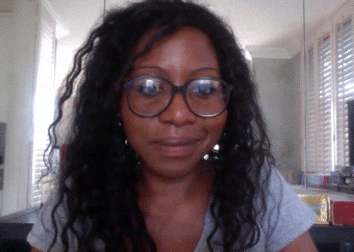
Animation by Amy Aniobi and Lisa Larson-Walker
“It’s super gratifying to be on an HBO show with black people,” said Aniobi. “This is the first black show on HBO for how long? I’m talking about a show about a black person, written by a black person. When did HBO last have that? This is history.” (It’s been a while.)
This kind of creative freedom pays off. Grey’s Anatomy fans may recall an episode from Season 8 in which a white character excitedly refers to his adopted black daughter’s “kitchen.” (Kitchen is a term used by black women to describe the particularly kinky hair at the nape of the neck.) It was a rare instance of a network TV show using a culturally black term that hasn’t penetrated the “mainstream.” Former Grey’s writer Zakiyyah Alexander was in the room for the development of that episode, and remembers the writers discussed whether or not to explain the word’s meaning for nonblack viewers. “I just thought, this is the kind of episode that could only happen if you have a black woman working for you,” she said. “And more than one. Because Shonda alone wasn’t enough to go, yes, this is funny, this is where we’re coming from, this is something that we experience.”

Don't miss out on this members-only, spoiler-filled recap of Empire, Season 2 from Slate's TV Club. Not a m ember? Try S+ free for two weeks!
What do you get when you tell new stories compellingly, interestingly, and truthfully? As of late, you get a hit, both critically and financially. For years there’s been evidence that the belief that you can’t make money with TV featuring nonwhite characters is nonsense. But the 2014–15 season put a stake in that idea’s heart. Empire grew its audience week after week, was a hit overseas, and is, as Slate’s Willa Paskin has written, the most important show currently on TV. Jane the Virgin maintained consistently solid ratings and helped the CW reach new heights. In the spring, star Gina Rodriguez won a Golden Globe for her fully realized, beautifully rendered character. (“This award is so much more than myself,” she said. “It represents a culture that wants to see themselves as heroes.”) This fall, Viola Davis won an Emmy for the similarly three-dimensional character she plays on How to Get Away With Murder. (She thanked her HTGAWM team, including exec-producer Rhimes and showrunner Peter Nowalk for redefining “what it means to be beautiful, to be sexy, to be a leading woman, to be black.”) Those shows, plus Fresh Off the Boat and Black-ish, were all well-reviewed and renewed. (Cristela, the other notable diverse show from last season, was not so lucky.) It was just a small sliver out of the entire television landscape, but these were shows that proved that people of color’s stories can succeed in the market without resorting to one-dimensional stereotypes.
So how to build on the limited success of the past year and bring a wider array of voices and faces behind the scenes, and not just on screen? It’s time to stop placing the burden on diversity programs, relying on the few execs who are willing to take chances on people of color, or seeing the success of Scandal and Empire as evidence that there’s no problem to solve. Instead, every showrunner should be forced out of his comfort zone. What if the Writers’ Guild incentivized—or, why not, mandated—multiple nonwhite hires in every union-staffed writers’ room? One of the most common reasons showrunners give for not having diverse writers’ rooms is that they just don’t see enough writers of color from whom to choose. Said Damon Lindelof, creator of The Leftovers, earlier this year: “If I’m staffing a show, I’m going to get sent 40 scripts for people, and of those 40 scripts, how many of them were written by any people of color? … The pool that I’m being told that I should be picking from is a majority white male pool.” (Carlito Rodriguez landed a staff position on Season 1 of The Leftovers due in large part to a chance meeting with Lindelof in a Starbucks, which put him on the showrunner’s radar once the show was picked up by HBO.) Why not force showrunners to go beyond relying on what they are sent by agents—to actively seek out new voices? Why not give agents an incentive to dig deeper and find more writers of color?
And what about the studios who make deals with the same showrunners year after year? Stacy L. Smith, director of USC’s Media, Diversity, and Social Change Initiative, has argued for a Hollywood version of the NFL’s Rooney Rule, which mandates that a nonwhite candidate must be interviewed for every head-coaching position. (While flawed, it has had a notable impact on the NFL’s head-coaching demographics—in 2001, two years before it was enacted, there were only two nonwhite head coaches; today there are six.) If studio executives were required to interview a certain number of diverse candidates for senior-level showrunner and executive producer deals, it could change the playing field for writers of color.
Studios should also hold themselves accountable for encouraging underrepresented voices in more senior positions. “Maybe there’s a fund that says, there’s a certain amount of money dedicated every year to a diverse writer and a diverse project, and they’re gonna shoot their pilot, ” suggested Jones. (The British Film Institute instituted a similar incentive last year, requiring all eligible projects to meet certain standards of diversity in order to receive Lottery funding.) Even if networks are unwilling to commit to shooting a pilot, why not take some of the money devoted to placing nonwhite beginning writers on shows and spend it on development deals with producers and showrunners of color? Making a commitment to one or two such people in senior positions will go a lot further in diversifying a network’s voices than throwing individual writers of color into writers’ rooms that don’t know what to do with them.
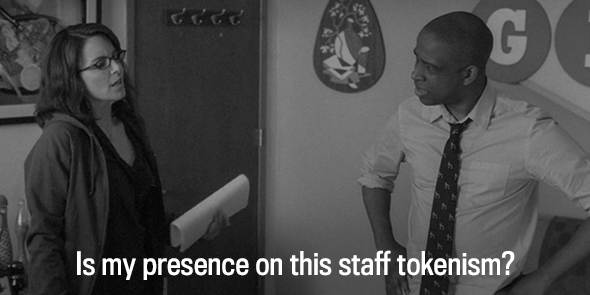
Stills via NBC, animation by Lisa Larson-Walker
This isn’t just the right thing to do—it’s the right move from both a business and creative standpoint. Increasingly, predominantly white audiences aren’t needed for a show to do gangbusters ratings, as Empire, with its overwhelmingly black audience, clearly demonstrates. Latinos continue to be the fastest growing TV-viewing demographic among viewers aged 18–49, and Asian-American audiences have grown as well. “People have started to realize, ‘Oh yeah, we don’t have to worry about making white people like them,’ ” said Vali Chandrasekaran, a co-executive producer of Modern Family who went through NBC’s diversity staffing initiative in its early years. “Because if they have a big enough fan base, that’s all you need.” And writers of color like Jones, Aniobi, and others have more to contribute than just their racial background. Writing for Silicon Valley last season was the “sweet spot” for Aniobi’s comedy style: “I’m the nerd and I like nerd humor, I like guy humor, and I like tech. I was already reading tech blogs before I ever was on Silicon Valley.”
The new fall season suggests Hollywood seems to be catching on to the value of diversity. But then again, that’s what Hollywood does: It sees a formula that works, and then it pumps it for all of the cash it can produce. Producers, said Mazzara, “are not going to change because it’s the right thing to do. They’re going to change because it leads to critical success, and viewership, and ad dollars.” Which means that things could easily go south again, when the next winning formula comes along. “They will put me out and then lock the room again,” said Gray. “If there’s nobody forcing them to do it, they’re lazy, they sometimes just don’t care.”
That hasn’t stopped Gray from pursuing her love of comedy writing. As of late, she’s been pitching two TV projects to both network and cable, and plans to continue writing while preparing for the upcoming staffing season over the next year. Despite the disappointing statistics on writers of color—and despite the fact that she currently has no staff-writing job—she says she remains optimistic about the industry, like many of the other writers I spoke with. “I look forward,” she told me, “to the day when diversity in the writer’s room [and elsewhere] is seen as the benefit it is and not a burden.”
